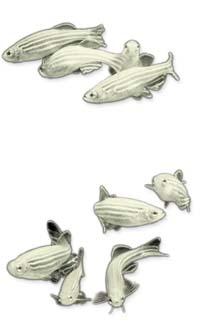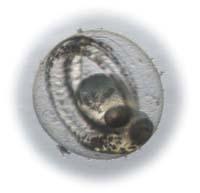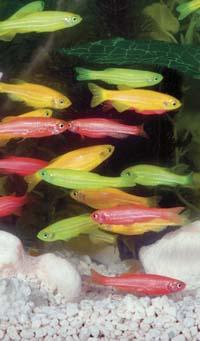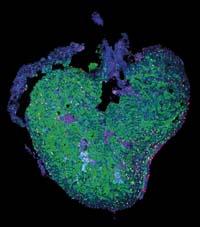Laboratory star with stripes
2009/05/01 Rementeria Argote, Nagore - Elhuyar Zientziaren Komunikazioa Iturria: Elhuyar aldizkaria

Zebrafish is one of the animal models used in the laboratory. It is less known than mouse and lab rat, but more and more is used. It has not been incorporated into the laboratory, began to be used for research in the 1970s, at the University of Oregon, and in this last decade is rapidly spreading to laboratories around the world.
Many laboratories choose zebrafish because of their few ethical problems, mainly because of the use of embryos instead of adult specimens. In addition, it seems that working with this fish is very simple, and thanks to this facility, many laboratories in Euskal Herria and its surroundings work with zebrafish.
Being a relatively new animal model, it is considered necessary to unify the laboratory working methodology with this fish. In fact, each laboratory has its own way of working (anesthesia and euthanasia protocols, for example). In order to unify the working method, several companies and research centers have created a platform. Its name is <UNK> net, acronym of the scientific name of zebrafish ( Danio rerio).
<UNK> net is coordinated by AZTI-Tecnalia and is formed by the Centre for Developmental Biology of Andalusia (CABD-CSIC) and the Biomedical Research Park of Barcelona (PRBB). In the words of the coordinator of the platform, Miguel Ángel Pardo, of AZTI-Tecnalia, -coordinator of the platform -, “the main objective of the platform is that everyone who works with zebrafish have contact, unifying methodologies and extending the use of the platform to the whole state”.

The Pardo group uses zebrafish to test new components and molecules related to food. For example, they investigate the influence of molecules that can help reduce or thin the tension or cholesterol level. But before the food department, zebrafish came to aquaculture at AZTI-Tecnalia. It was logical, if it was an appropriate model for man, so much better for other fish. Therefore, they were used to investigate resistant genes from farm fish diseases, such as turbot or trout.
The destiny of the transparent
Zebrafish is a good animal example for fish, of course, and also for man. It is a well known species, known almost entirely by the genome and whose parity with man is around 85%. In addition, its growth is fast and does not require special care, so you can work with a large number of specimens, obtaining results quickly.
But what most characterizes this fish is transparency: the embryo is transparent and therefore its interior is visible. It is therefore ideal for investigating organ growth. In fact, laboratories began to use zebrafish to investigate embryogenesis, that is, to know the origin and growth process of the embryo.

In this sense, in recent months there have been two milestones in zebrafish research related to the transparency of this animal. The first is that they have recorded the birth of an embryo and the entire growth cycle (in toto, as scientists say, in its entirety). Research at the European Molecular Biology Laboratory (Germany) has spread to the four winds.
Another news related to zebrafish is that the Boston Children's Hospital has also achieved a transparent zebrafish in adulthood, so that also in adult specimens can follow the research undertaken with the embryo. This transparent zebrafish or albino is used, among other things, to investigate the development and spread of cancer.
Organ Research
As can be seen, zebrafish transparency is a special feature for research. As for growth, organs have a great interest. Well, to track the growth of an organ, the most common thing is to highlight the organ of the zebrafish embryo with a fluorescent marker. In this way you can directly observe the organ, with the help of a suitable magnifying glass and without sacrificing the animal, which is alive as it grows.

In the company Biobide in Donostia-San Sebastián they work more or less like that. Zebrafish is used to test drugs. In Biobide they breed transgenic zebra fish adapted to each drug. In order to check if a drug produces side effects in the heart, embryos that have the heart highlighted with a fluorescent substance grow. In order to check if another drug influences blood vessels, GMOs grow that are highlighted.
The use of zebrafish is cheap and simple, before testing it with mice or rats, to decide whether a drug should move towards the market. In the words of Arantza Muriana, from Biobide, "it is intended that the affected agencies accept zebrafish as an animal model for pharmaceutical and biotech companies to use it to test new drugs," which is what they demand by joining forces through the <UNK> net platform.


Gai honi buruzko eduki gehiago
Elhuyarrek garatutako teknologia




